Cummins Marine Diesel Repower Specialists › Forums › General Discussion › New boat, new to diesels
- This topic has 19 replies, 7 voices, and was last updated 4 years ago by
 Brad Arrington.
Brad Arrington.
-
CreatorTopic
-
April 17, 2019 at 12:16 pm #67081
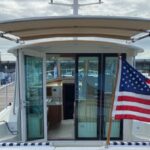
Brad ArringtonParticipantVessel Name: Jennifer B.
Engines: QSC 8.3 600
Location: Long Island, NY
Country: US
Hi all, I’ve put in an offer on a new boat and am getting ready to see it for the first time. Coming from a freshwater cooled Mercruiser outdrive setup, the transition to a straight shaft diesel is quite a change. I’ve been doing some research but still feel very much the newbie.
What kinds of things should I look for upon my initial viewing of the boat? Assuming all goes well, what kinds of things are important that I should do relative to a survey?
The boat is a 2013 Back Cove 34 with a QSB 5.9 480, 350 hours. It is currently in fresh water and supposedly has been “regularly serviced by the selling dealership”. I’ll be moving it to salt water. Unlike myself, the current owner is reported to be very hands-off and not mechanically inclined.
Thanks for any suggestions or guidance on my new journey into diesel operation.
-
CreatorTopic
-
AuthorReplies
-
July 1, 2019 at 7:58 am #74517

Brad ArringtonParticipantVessel Name: Jennifer B.
Engines: QSC 8.3 600
Location: Long Island, NY
Country: US
Tony, I defer to your expertise.
I can say that the oil has just been changed. The sea trial was performed on commission so it had not been run. There was almost zero time on the new oil. The boat had not been idled dockside on the changed oil. It was at near idle speed for 10-15 minutes each way in a no-wake zone to and from the sea trial area. During the sea trial the engine was at temp and run at a variety of speeds for about 30 minutes. It was cut short and returned to the dock when the leaking shaft seal was discovered. The oil samples were taken about an hour after returning to the dock.
Regardless of the cause, the boat was just not cared for. It worked out because I found a NEW model that I’m about to close on. Any care will be from me, and I look after my equipment.
June 27, 2019 at 7:45 pm #74406
Tony AthensModeratorVessel Name: Local Banks
Engines: QSB 6.7 550 HP
Location: Oxnard, CA
Country: USA
Just an FYI—Oil dilution with fuel would not be related to overheats.. This would normally be attributed to a lot of operation at very low speeds with no high cruise running for a few minutes at each cycle, lots of dock side start up without leaving the dock never getting the engine up to temp, cold coolant temps and/or lousy oils change intervals.. On a mechanical engine, a lousy injector will also cause this.. On a QSB, usually other things happen if you have a crap injector.
Tony
June 27, 2019 at 3:59 pm #74399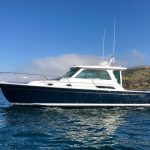
SteveParticipantVessel Name: Cabrillo
Engines: QSB 5.9 425hp
Location: Huntington Beach, CA.
Country: USA
Too bad….Trashing a quality boat like that (especially when it’s so new) is just criminal. The owner should be locked up.
June 26, 2019 at 8:23 am #74299
Brad ArringtonParticipantVessel Name: Jennifer B.
Engines: QSC 8.3 600
Location: Long Island, NY
Country: US
One last update
I got oil analysis results back from the mechanicals.
– Generator was fine.
– Transmission showed wear contamination consistent with 250 hours of use vs the actual 2 hours. Heavy internal wear.
– Engine showed wear is fine, but significant fuel dilution if the oil. Likely from those multiple overheat events. I have a feeling this engine is toast.June 4, 2019 at 6:31 pm #72862
Brad ArringtonParticipantVessel Name: Jennifer B.
Engines: QSC 8.3 600
Location: Long Island, NY
Country: US
Not so good
Had the sea trial today and though I would close the loop.
The surveyor uncovered a few issues. Let’s start with the minor ones and work up.
Leaking hot water heater pressure relief valve.
Shower sump box pump inoperative. Overflowing directly into the engine bilge.
Water leak near generator (source unknown – not from genny.
Finicky electric stove.
1 of 3 AC units is bad (no cooling)
When on generator, the main breakers tripped when the stove was turned on and the AC units were on. Not nearly at capacity – weak breaker suspected.
Shore power – 1 of the 2 legs had no power. Confirmed in-boat issue.
Fully eroded zincs on
Poor condition of forward engine bonding wire.
Noisy transmission. Sounds like driving over gravel.
Heavy leak on shaft seal. Spraying water on transmission and other areas.
Heavy driveline vibration at certain RPMs. Leak, tranny and vibration possibly from shaft or alignment issue.
Engine code scan revealed 4 separate instances of engine overheating – “most severe” level.
There were some other cosmetic issues, but those pale in comparison. Overall, the boat showed signs of just not being maintained well. Rode hard and put away wet.
Needless to say I’m walking away. Too bad – it was once a very nice boat before the current owner got it. A 6 year old boat doesn’t deserve this.
May 23, 2019 at 3:11 pm #69992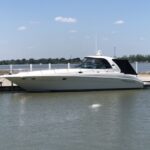
Steve LewisParticipantVessel Name: Just Us
Engines: Cummins 480CE
Location: Marblehead, OH
Country: USA
What matters most
Brad,
Yes I do see that in the high range of what is considered acceptable the fuel burn falls under the Cummins curve but I ask you this….. Will you really be running your boat/engine at 2800-3000 RPM all of the time? I submit that you will not. Based on sea conditions you will be adjusting your speed down. Long Island sound is not flat as glass. You will encounter some waves that would make most prudent captains slow down thus putting the engine into the fuel burn condition that is over the curve. Not to mention that the BC test was a fresh boat. Older boats slow down and just plain get heavier. The goal will be to have the prop tuned so that you will be under the curve for the MAJORITY of your boating conditions but not all. We do concede that there will be transient conditions where the fuel burn will be over the curve. As long as that does not last for hours on end and is only for a short time then that is OK. And then there will be those days where weather blows up and you come off plane and run at hull speed to get home safe. NO issues there at all.
At the end of the day what really matters is what your boat ends up burning. THe only way to figure that out is to go out on a sea trial or a cruise and plot the numbers. I am willing to bet a case of Dog Fish Head 90 minute IPA that the numbers will be well above the Cummins Curve.
Cheers Mate!
May 23, 2019 at 10:20 am #69970
Brad ArringtonParticipantVessel Name: Jennifer B.
Engines: QSC 8.3 600
Location: Long Island, NY
Country: US
Side-by-Side data plot
Brad,
I have attached the factory performance test for your model of boat and engine and then also attached the fuel curve from Cummins for same engine. You will see that in the very important cruise RPM range, the engine is overloaded. From the factory! I am going to pile onto one of Rob Schepis’ comments. Potential overpropping. Dare I say it is pretty much a given that your boat is overpropped. I highly recommend doing what Rob says and once the boat goes in the water(Sea Trial?) you chart your fuel burn at the cruise RPM range. Looks like 2200 – 2800 by my estimates. Plot your fuel burn numbers against the Cummins fuel burn numbers. The numbers on the Cummins chart are the ones you need to stay below in the Cruise range. That will most likely mean you will need to have some prop work done. By that we mean have some inches of pitch removed. That will unload the engine a bit and get the fuel burn down. The voodoo is how much pitch will do that. Find a good prop shop and tell them your numbers and the goal and they will be able to get your prop sorted.
Just a thought…….
If you have not bought it yet and you have the ability to modify your offer based on the outcome of the survey and sea trial, you might negotiate some of these items by having the seller offset the cost of the items by lowering the price.
Good Luck!
Steve,
I made a new chart that combines both the Back Cove and the Cummins data to show the fuel consumption metrics provided by both. I would agree that for the tested installation, the Back Cove’s fuel consumption is higher than Cummin’s rated fuel consumption for the prop demand charts in certain areas. It is primarily in the mid area.
However, for what you call the all-important cruise RPM range (let’s call this 2800-3000), the tested fuel consumption is right in line with Cummin’s specs. At the “rated” cruise speed of 3000 rpm the GPH actually .4 GPH below the rating.
Now, what to make of this higher GPH in the mid RPM range? Is the engine being overloaded? Does it indicate an overpropped condition? This I don’t know – I’m not experienced enough in these metrics.
For the particular boat I’m looking at, I don’t know if the prop matches that used to obtain Back Cove’s test data. I will work with the surveyor during the sea trial to plot the RPM / fuel burn data. In the mean time, I’d appreciate if anyone can offer any confirmation or insight to the data I’ve plotted.
May 22, 2019 at 9:40 am #69929
Steve LewisParticipantVessel Name: Just Us
Engines: Cummins 480CE
Location: Marblehead, OH
Country: USA
Factory Performance Test
Brad,
I have attached the factory performance test for your model of boat and engine and then also attached the fuel curve from Cummins for same engine. You will see that in the very important cruise RPM range, the engine is overloaded. From the factory! I am going to pile onto one of Rob Schepis’ comments. Potential overpropping. Dare I say it is pretty much a given that your boat is overpropped. I highly recommend doing what Rob says and once the boat goes in the water(Sea Trial?) you chart your fuel burn at the cruise RPM range. Looks like 2200 – 2800 by my estimates. Plot your fuel burn numbers against the Cummins fuel burn numbers. The numbers on the Cummins chart are the ones you need to stay below in the Cruise range. That will most likely mean you will need to have some prop work done. By that we mean have some inches of pitch removed. That will unload the engine a bit and get the fuel burn down. The voodoo is how much pitch will do that. Find a good prop shop and tell them your numbers and the goal and they will be able to get your prop sorted.
Just a thought…….
If you have not bought it yet and you have the ability to modify your offer based on the outcome of the survey and sea trial, you might negotiate some of these items by having the seller offset the cost of the items by lowering the price.
Good Luck!
1 user thanked author for this post.
May 21, 2019 at 5:40 am #69820
Tony AthensModeratorVessel Name: Local Banks
Engines: QSB 6.7 550 HP
Location: Oxnard, CA
Country: USA
Exhaust
If the surveyor or tech you pay do not mention, on their own, about your exhaust is “doomed to failure” besides not meeting Cummins requirements, IMO, then neither are not worth their salt..
If this vessel is going into salt water, service the aftercooler (on the bench) immediately after taking possession..
Tony
1 user thanked author for this post.
May 21, 2019 at 5:10 am #69815
Brad ArringtonParticipantVessel Name: Jennifer B.
Engines: QSC 8.3 600
Location: Long Island, NY
Country: US
Thanks for the info Rob.
I don’t know why the air cleaner was removed. I thought it odd. The boat is on land for maintenance.
The amount of mildew is a concern to me. It’s pervasive, and indicates high moisture that needs to be addressed. The bilge space in front of the engine has evidence of high standing water that needs to be explained.
I thought the shaft seal area was questionable; thanks for the confirmation.
The rest will be looked at by a surveyor and Cummins tech.
May 20, 2019 at 12:28 am #69756
Rob SchepisForum ModeratorVessel Name: Tenacious
Engines: 6BTA 5.9 330's - "Seaboard Style"
Location: Long Island, NY
Country: USA
Why was the air cleaner removed and not installed?
As to the mold/mildew —- Overall engine/engine room needs TLC for moisture/corrosion control. Cleaning/lubing all metals and connections. Remember, this is an electronic engine, you have a lot of sensors, connections and components that are just waiting for the gremlins to appear…
Signs of leaking PSS shaft seal – need to investigate and perform proper repair
Potential over propping based on turbo discoloration – need to plot fuel burn at 200 rpm increments throughout full rpm range
Exhaust is “doomed to fail” – need to replace with custom dry riser
https://www.sbmar.com/articles/marine-exhaust-risers-that-are-doomed-to-fail/
https://www.sbmar.com/services/custom-marine-exhaust-design/
1 user thanked author for this post.
May 18, 2019 at 7:31 pm #69705
Brad ArringtonParticipantVessel Name: Jennifer B.
Engines: QSC 8.3 600
Location: Long Island, NY
Country: US
It’s a 6.7
I got up to see the boat today and took a bunch of photos of the engine. Looking at serial number tag seems to show the engine is a QSB 6.7 vs. the QSB 5.9 that was listed.
Other than the engine space having a fair amount of mildew, nothing looked obviously amiss but I don’t really know what to look for.
May 17, 2019 at 7:45 am #69563
Brad ArringtonParticipantVessel Name: Jennifer B.
Engines: QSC 8.3 600
Location: Long Island, NY
Country: US
Brad,
Did you end up buying the Back Cove? We transitioned from a Grady White w/twin outboards to our 08 Back Cove 33 w/qsb 5.9 (425 hp). It was an experience moving to the single diesel but I have to say after 2.5 years we couldn’t be happier. I’m curious to see what you think of the boat/engine etc?
Thanks,
Steve
Steve,
I’m still working on getting the Back Cove. I’ve been under contract for a while but the boat has been unavailable for me to see as it’s been under wraps then in a paint shed being Awlgripped. I’m going to see it tomorrow. If all goes well, I’ll set up the survey and sea trial.
I’ve always been a single-engine boater so hopefully it won’t been too much of a transition. Although, my current Sea Ray has a duo-prop Bravo 3 setup that makes docking and handling pretty easy. Getting used to the prop torque may take some time.
I’ve been looking at Back Coves and the 33/34 models for about 8 years, as they are the only single-engine boat of their size that will cruise at about 26-27 mph. Since I’ve not been able to get a ride on one yet I really hope it’s as good as the story I’ve built up for myself.
Brad
May 14, 2019 at 2:14 pm #69420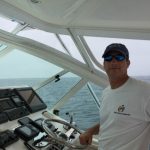
PhilipParticipantVessel Name: 2007 35’ Cabo ‘FUGA’
Engines: Cummins QSC8.3-540’s
Location: Long Beach, CA
From the small picture posted I would be looking closely at how the boat is propped and how much fuel it is burning at 200 rpm intervals up to max rpm. The turbo looks a little dark and could indicate it’s overpropped. At 350 hours if all else falls into place some prop work would be reasonable expectation.
1 user thanked author for this post.
May 14, 2019 at 10:41 am #69403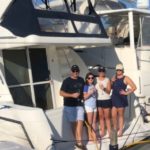
Brian KatzParticipantLot’s of Cummins powered boats here on Long Island. If you buy this boat or not just start reading the forums and Tony’s tips and puzzle pieces will start to fall in place. Propping and the raw water loop are a good place to start.
Good luck.
1 user thanked author for this post.
May 10, 2019 at 9:31 am #69179
SteveParticipantVessel Name: Cabrillo
Engines: QSB 5.9 425hp
Location: Huntington Beach, CA.
Country: USA
Brad,
Did you end up buying the Back Cove? We transitioned from a Grady White w/twin outboards to our 08 Back Cove 33 w/qsb 5.9 (425 hp). It was an experience moving to the single diesel but I have to say after 2.5 years we couldn’t be happier. I’m curious to see what you think of the boat/engine etc?
Thanks,
SteveApril 22, 2019 at 7:37 am #68141
Brad ArringtonParticipantVessel Name: Jennifer B.
Engines: QSC 8.3 600
Location: Long Island, NY
Country: US
Good for you to find a boat in freshwater, that is a premium, especially in a situation where maintenance might not have been up to high standards. Up the Hudson I presume?
Single screw, right?
Be sure to take a lot of engine room pic, some close ups and some overall shots. Be sure not to miss the biggies – engine mounts, seawater pump, aftercooler, turbo, exhaust coming off the turbo, digital display, to name a few…
Get the engine serial number. Get the info off of the gear (tranny) tag.
Will this visit include a sea trial?
Request a cold start, meaning the engine sat at least overnight. Put your hands on the engine before they fire it up. Should feel the same temp as something like the seawater strainer.
Record the fuel burn throughout the rpm range, use intervals of 200 rpms, and go all the way to wide open throttle (WOT). Record %Load at WOT too. Keep an eye on coolant temperatures and see if they climb with increasing rpm’s.
Take note of fuel and water tankage levels to get an idea as to how heavy or light the boat is.
Ask for maintenance records. If the current owner is “hands off” as stated then he should have receipts for everything..
Sorry, I replied earlier but it didn’t post for some reason!
Yes, the boat is a a single screw and is up on the Hudson. TBH, when I made my offer I didn’t focus on the fact that it is in fresh water but it’s a bonus now. I’m not sure that it was always in fresh water though.
Thanks for the tips. I’ll be sure to check those areas and try to get the serial numbers, etc. This initial visit won’t include a sea trial. It will be the first time to see the boat in person to ensure the condition matches to photos before going further with the purchase. The boat is having some maintenance done – including a complete Awlgrip job on the topsides – and won’t be ready for a sea trial for a few weeks.
April 17, 2019 at 2:03 pm #67089
Brad ArringtonParticipantVessel Name: Jennifer B.
Engines: QSC 8.3 600
Location: Long Island, NY
Country: US
Good for you to find a boat in freshwater, that is a premium, especially in a situation where maintenance might not have been up to high standards. Up the Hudson I presume?
Single screw, right?
Be sure to take a lot of engine room pic, some close ups and some overall shots. Be sure not to miss the biggies – engine mounts, seawater pump, aftercooler, turbo, exhaust coming off the turbo, digital display, to name a few…
Get the engine serial number. Get the info off of the gear (tranny) tag.
Will this visit include a sea trial?
Request a cold start, meaning the engine sat at least overnight. Put your hands on the engine before they fire it up. Should feel the same temp as something like the seawater strainer.
Record the fuel burn throughout the rpm range, use intervals of 200 rpms, and go all the way to wide open throttle (WOT). Record %Load at WOT too. Keep an eye on coolant temperatures and see if they climb with increasing rpm’s.
Take note of fuel and water tankage levels to get an idea as to how heavy or light the boat is.
Ask for maintenance records. If the current owner is “hands off” as stated then he should have receipts for everything..
Yes, the boat is on the upper Hudson river and is a single screw. Thanks for the suggestions on what to photograph and look for when running.
The first visit will not be a sea trial but to see it in person vs. just seeing it in photos. The boat isn’t in the water yet as it’s being commissioned and having some maintenance done, including brightwork touch ups, all new batteries installed, misc other items, and getting an Awlgrip paint job. That will all take a few weeks to a month before it’s ready to splash. I want to see the boat in person before setting up surveys, sea trials, and transferring deposits.
Attached is the only photo I have of the engine space. I’m sure it doesn’t show much.
April 17, 2019 at 1:14 pm #67087
Rob SchepisForum ModeratorVessel Name: Tenacious
Engines: 6BTA 5.9 330's - "Seaboard Style"
Location: Long Island, NY
Country: USA
Good for you to find a boat in freshwater, that is a premium, especially in a situation where maintenance might not have been up to high standards. Up the Hudson I presume?
Single screw, right?
Be sure to take a lot of engine room pic, some close ups and some overall shots. Be sure not to miss the biggies – engine mounts, seawater pump, aftercooler, turbo, exhaust coming off the turbo, digital display, to name a few…
Get the engine serial number. Get the info off of the gear (tranny) tag.
Will this visit include a sea trial?
Request a cold start, meaning the engine sat at least overnight. Put your hands on the engine before they fire it up. Should feel the same temp as something like the seawater strainer.
Record the fuel burn throughout the rpm range, use intervals of 200 rpms, and go all the way to wide open throttle (WOT). Record %Load at WOT too. Keep an eye on coolant temperatures and see if they climb with increasing rpm’s.
Take note of fuel and water tankage levels to get an idea as to how heavy or light the boat is.
Ask for maintenance records. If the current owner is “hands off” as stated then he should have receipts for everything..
1 user thanked author for this post.
-
AuthorReplies
You must be logged in to reply to this topic.
